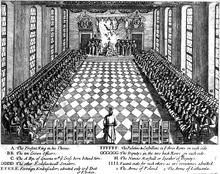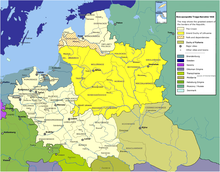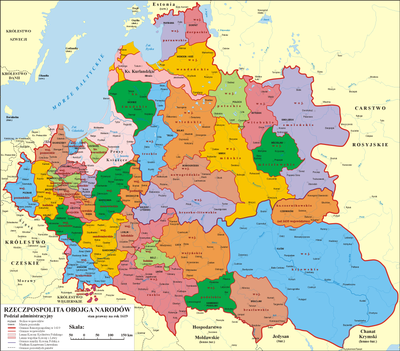Polish–Lithuanian Commonwealth
Poland-Lithuania (also called Rzeczpospolita or Royal Republic, and in Latin Respublica Poloniae) was a state in Central and Eastern Europe existing from 1569 to 1795. The dualistic, federal and feudal Estates State had elements of a republic based on a parliamentary-constitutional monarchy (monarchia mixta) and a ruler at the head of state elected by a majority of the aristocracy in a free election.
Since an elective monarchy had been introduced after the extinction of the Jagiellonian dynasty and the parliament of the estates, the Sejm, which essentially represented the interests of the aristocracy, had been given extensive powers, one often speaks of a noble republic and, referring to the Polish states after 1918, of the First Polish Republic.
The two namesake countries, the Kingdom of Poland (Polish usually simply called Korona or the Crown) and the Grand Duchy of Lithuania, were united in a personal union as early as 1386. At its greatest territorial extent around 1618, the area included most of the territory of present-day Poland, present-day Lithuania, Latvia and Belarus, as well as parts of present-day Russia, Estonia, Romania, Moldova and Ukraine.
Poland-Lithuania was a multiethnic state whose heterogeneous ethnic populations followed a wide variety of religious denominations. Catholic, Protestant, Orthodox and Armenian Christians, as well as Jews and Muslims, lived here side by side and enjoyed politically supported religious freedom despite the dominance of the Catholic clergy.
With the Real Union of 1569, the Kingdom of Poland and the Grand Duchy of Lithuania as well as Royal Prussia and the Duchy of Livonia merged into a common body of state. The rural areas of Royal Prussia were also administered by Polish starosts, but the city republics of Danzig, Thorn, and Elbing, as well as the Prince-Bishopric of Warmia, were given a large measure of extensive autonomy. Other territories, such as the Duchy of Prussia, the Duchy of Courland and Semigallia, and for a time the Danubian principalities of Moldavia and Wallachia, were subject to Poland-Lithuania only as fiefs. Poland-Lithuania also held until 1772 the Spiš towns, which had been pledged by the Kingdom of Hungary to the Kingdom of Poland in 1421.
History
Lublin Real Union
By the Union of Lublin of August 12, 1569, the personal union created in the Union of Krewo in 1385 was transformed into a real union for lack of heirs to the throne of Poland and Lithuania. The new state was called the Commonwealth of the Two Nations. It was an elective monarchy with a common currency, a common parliament (the Sejm), and a monarch. Participating in the election were the aristocracy, which made up about 10% of the population (significantly more than in most other European states), and the bourgeoisie of the autonomous city republics. The lower Polish nobility was called the szlachta, the high the magnates. Because of its aristocratic elements (elective kingship with strong position of the noble parliament Sejm) this state is also called noble republic. Even before the reform of 1791, the Sejm had significantly greater powers, for example in matters of foreign policy or even noble predicates, than the British Parliament at the time.
However, each of the two parts of the empire had its own army, headed by a grand hetman and a field hetman. At the Electoral See of 1697, the equality (coaequatio jurium) of the Lithuanian and Polish nobility was decided. This curtailed the prerogatives of the grand hetman of Lithuania, who had previously dominated the grand princely half of the empire. At the same time, the Ruthenian (Old White Russian) language of chancery in the Grand Duchy of Lithuania was replaced by Polish.
Elected kings
The kings after the establishment of the Polish-Lithuanian personal union until the Union of Lublin were, with the exception of Jogaila, all born in Poland and, with the exception of Sigismund the Old, all born in the royal city of Krakow.
At the first opportunity to freely elect a king, the Sejm chose a foreigner, the Capetian Henry of Valois from France, in May 1573. Only a year later, however, the latter secretly left Poland to become King of France after the approaching death of his seriously ill elder brother Charles IX. As a result, Anna Jagiellonica, daughter of the penultimate Jagiellonian Sigismund I the Old, still unmarried at 52, was elected king (not queen) and a male candidate for king was sought on condition that he marry her. Stephen Báthory, a Transylvanian Hungarian, had the advantage for the Sejm of not being connected to any of the great European dynasties. Ten years younger than his wife Anna, however, he died ten years before her.
Anna successfully supported the election of her Swedish nephew Sigismund III. Wasa as king and grand prince in 1587. After the latter's death, the Sejm elected two of his Kraków-born sons as head of state in succession.
The next two kings were descended from native noble families, albeit from places that are no longer part of Poland, Michael Korybut Wiśniowiecki in 1669 and John III Sobieski in 1674, who made a decisive impact on the history of Europe when the Polish army and its allies defeated the Ottoman army outside Vienna in 1683.
In 1697, a foreigner was again elected in the person of the Saxon Elector Friedrich August I of Saxony, who became Polish king as August II. However, the Electorate of Saxony was weaker than Poland's five potent neighbors, Sweden, Russia, the Ottomans, the Habsburg Empire, and the Kingdom of Prussia. Nevertheless, Polish politics were now strongly influenced by its neighbours and France, as reflected in frequently changing kings: in 1704 August II was replaced by Stanislaus I Leszczyński, and in 1709 August II was able to gain power once again. After his death in 1733, Stanislaus I was again elected Polish king by one party. The other party elected August III, the son of August II, which led to the War of the Polish Succession. After the death of August III, in 1764 Stanislaus II August Poniatowski, a local nobleman with good relations with the Russian tsar's court, was elected as what would turn out to be the last king and grand prince of the Polish-Lithuanian Republic.
Flourishing
In the early 17th century, Poland-Lithuania stayed out of the Thirty Years' War and expanded eastward, occupying the Kremlin in Moscow (1610) and the Black Sea coast in the Polish-Russian War of 1609-1618. Then, in the second half of the 17th century, the aftermath of the Second Northern War, internal strife, and strengthening neighbors Russia and Brandenburg-Prussia increasingly limited the power of Poland-Lithuania. The attempt to reform the state as a triune noble republic of Poland-Lithuania-Ruthenia failed in 1658 due to Polish resistance. Since 1697 the noble republic found itself as part of the personal union Saxony-Poland, which lasted with interruptions until 1763. In 1772 Poland-Lithuania covered 729,900 km² and had about 12 million inhabitants.
Divisions
→ Main article: Partitions of Poland
In the course of the 18th century the Rzeczpospolita became increasingly incapable of action and reform due to the Liberum Veto, which enabled its neighbours to achieve the First Partition of Poland. As a consequence of this and under the impression of the independence of the USA and the French Revolution, the liberal constitution of 3 May 1791 was created, abolishing the duality between Poland and Lithuania. The remaining parts of the aristocratic republic were united in a unitary state to form Rzeczpospolita Poland. The absolutist-ruled neighboring monarchies made the Second Partition of Poland two years later, and the Third and Complete Partition another two years later - not least because of similarities between the reformed Polish constitution and that of revolutionary France. Poland-Lithuania, like other once-sovereign states, disappeared from the political maps of Europe by 1918. The partitions involved the Kingdom of Prussia, the House of Habsburg and the Russian Empire.

The Sejm during the coronation of August II.

Failed reform attempt 1658: Noble Republic of Poland-Lithuania-Ruthenia
Administrative division
→ Main article: Administrative division of the Polish Noble Republic
Apart from the royal free cities (Gdansk, Thorn, Elblag and Riga), Poland-Lithuania was divided into voivodeships. The division of the territory of the Polish Crown into the Greater Poland and Lesser Poland provinces had a purely traditional meaning. Some dominions were legally equal to a voivodeship, e.g. the Prince-Bishopric of Warmia and the Duchy of Samogitia.

The I Rzeczpospolita in the borders after the Treaty of Deulino 1618 (administrative division into voivodships)
Questions and Answers
Q: What was the Polish-Lithuanian Commonwealth?
A: The Polish-Lithuanian Commonwealth was a state that was ruled by a common monarch and an extension of the Polish-Lithuanian Union.
Q: What territories did the Commonwealth cover?
A: The Commonwealth covered more lands than the present lands of Poland and Lithuania, including all of present-day Belarus, a large part of present-day Ukraine and Latvia, and the west of present-day Russia.
Q: How did the Commonwealth differ from other European countries of the time?
A: The Commonwealth had high levels of ethnic diversity and religious tolerance.
Q: Did the level of religious freedom in the Commonwealth remain constant over time?
A: No, the amount of religious freedom varied over time.
Q: What led to the decline of the Commonwealth?
A: After several decades of prosperity, the Commonwealth entered a period of political, military and economic decline.
Q: How did the Commonwealth come to an end?
A: The Commonwealth ended with the final Partitions of Poland in 1795.
Q: What was the cause of the Commonwealth's division?
A: The Commonwealth's growing weakness led to it being divided by its more powerful neighbours: Austria, Prussia and the Russian.
Search within the encyclopedia